Meet Your Meat.
Posted on | February 8, 2013 | 9 Comments
I realize heritage chicken breeds are all the rage in farming. Which is completely reasonable. The majority of heritage breeds are excellent dual purpose chickens, raised for egg production and for meat. My first hens were black Plymouth Rocks given to me by the uncle of a friend. Their history goes back to the 1800’s, they were a mainstay on American farms, and they still are today.
My hens lived in a movable chicken tractor. Which was big enough for a flock of 4 but small enough for the children to be assigned cleaning duty when their (mis)behavior demanded it.
True to their breed characteristics, my girls were calm and friendly, even tolerating manhandling from the children without pecking. Puffy was a favorite as she would hunch down in submission whenever the kids approached her, allowing her to be picked up easily.
They were good foragers and loved to get out and spend the afternoon digging in the leaf debris for tasty bugs.
And they were smart enough to know to take cover and never go home when the red tailed hawk was waiting on them.
Experience with a heritage breed is enough to get you hooked on chickens. Although you will be sure to make detours to flashy “newcomers” like the Ameraucanas and their blue green eggs. Blue and Chirpee were the first chicks we raised on our farm because we couldn’t resist the thought of those colorful eggs. I should have known Pretty was destined to be my farm manager when she was still smiling as chick poo ran down her leg.
Over the years we’ve had Wyandottes, Buff Orpingtons, and New Hampshires, among many others. But despite the fact that we always butchered extra roosters for meat and turned 3 year old layers into stew hens, we never raised any specific meat breeds.
I was horrified when I first saw a batch of broilers brought to the processing plant where we took our ducks to be butchered. The chickens were sickly, balding, and lethargic. The NCDA agent was searching through the crates, condemning birds before putting them on the line, and tossing half dead/half alive birds into barrels to be incinerated. Some of the birds had smothered, piling into the corners of the crates during transport. Many of the birds had either been cannibalized or had sores or scabs from injuries. I was expecting the farmer to be hauled off by police, but all the other farmers in line with their livestock were shaking their heads in commiseration.
“Such a shame,” they murmured. “Those birds are almost too stupid to live. Doesn’t matter how hard you try to raise them naturally. They end up looking diseased and feeble.”
And over the years I saw that this was the case. While waiting in line with my ducks, I always saw broilers coming in, looking nothing like the bright eyed and gloriously feathered cockerels we always caught and carried off to the monkey bars for butchering at home. Farmers explained to me how broilers were hard to transport for processing because their breasts were so large that breathing was difficult and they couldn’t handle a lot of stress. Also, due to their quick growth, their legs were weak so they didn’t walk around much on the farm and they were easily injured in the crates. To complicate things further, their feathers couldn’t fill in as fast as they grew, which left them with bare spots so they often pecked at each other. What was especially difficult for farmers in my area was that the processing plant did not have a reliable schedule. Most broilers only lived for 6-8 weeks before their hearts could no longer oxygenate all that muscle tissue. If the broilers reached their maximum age at a time when the processing plant decided to shut down for 2 or 3 weeks, the farmers ended up holding on and hoping the birds made it until they could be brought in to butcher. And when they were brought in, they often looked terrible.
When a neighboring farm began raising broilers on pasture, I saw that, even in an opportune environment, the birds weren’t anything like my free range chickens. My neighbor had a lovely pasture, with a movable canopy tent for shade, and a Great Pyrenees for protection. Yet those birds just sat there under their canopy tent. With acres of lush grass around them, they just sat there, next to the feeders and waterers. Eventually he would move the canopy to a new spot and there would be a large rectangle of bare earth, covered in feces and feathers, left behind. I never saw a bird stray out into the sunshine or chase a bug into the grass. I had never seen anything like it and it made me not the least bit interested in raising a meat breed of chicken.
Until Pip and Peep.
Pip and Peep were a pair of Jumbo Cornish Cross broilers given to us by a friend whose daughter hatched them as part of the embryology unit in school. Upon learning that the chicks wouldn’t live past 6 or 8 weeks, she handed them over to us so her children could be spared from watching a chicken cardiac arrest. They were ridiculously friendly. Since they were already 3 weeks old and were fully feathered, we simply put them in with the rest of our free range flock. We figured we’d butcher them in a few weeks. Or whenever we got to it.
We saw them every morning and night when we were tossing out feed for the flock. And they appeared to be doing just fine. Our flock has 4 acres to roam and several roosting areas in the coop, outside of the coop, and in the goat barn. So there’s no reason for the chickens to pick on newcomers and there’s space for both the dominant and the submissive members of the flock. As soon as we came out to the barn yard, Pip and Peep would be at our feet, pecking at toes and fingers, hoping for handouts.
They didn’t stray all the way down the driveway or into the woods by the property line. But they did wander all over the barn yard, into the buck pasture, and out of the fencing into the front yard. They didn’t actually scratch and they didn’t roost, but they did peck around, they took dirt baths, and they hung around with the other chickens with ease. They even came running at full speed whenever the scrap bucket was brought outside. It wasn’t the smoothest of gaits, somewhere between a duck waddle and a drunken cowboy, but it was effective enough to get a good piece of the kids’ sandwich crusts from their lunchboxes.
I waited for their legs to get weak. I waited to see them struggling to breathe. I waited to see them stop wandering around and just sit. I waited for them to act lethargic or not be ready to eat every morning. But it didn’t happen at 6 weeks old. Or 8 weeks old. Or 12 weeks old. So then I did what I do best. Got distracted and stopped thinking about them.
Pip and Peep, as well as the extra roosters we ended up with, were all April chicks. So they should have been butchered around October. Cockerels make a nice size meal at 6 months old and, besides, I hate to feed extra chickens through the winter when they need more grain due to fewer bugs and insects around. Too bad October has Halloween. And November has Thanksgiving. December has Christmas and January has New Year’s Eve.
Not to mention all my kids are school age now. So there’s no more wandering outside on a random chilly weekday morning and deciding it’s a good time to butcher. I believe the school considers “staying home to butcher roosters” as “unexcused.” I’m fully capable of butchering without the extra hands but it seems to defeat the purpose of the family farm. Plus, I try to squeeze every ounce of return out of those 36 months of pregnancy. And my weekends are now filled with birthday parties and basketball games, sleepovers and scout events. So 6 month old roosters quickly become 9 month old roosters.
They might have even gotten older than that. Except for the fact that one day, as I emptied the waterer, Pip came over to wait for a drink. And I noticed a weird spot under his wing. He stood quietly as I lifted his wing. He looked at me with surprise as I gasped in horror.
His skin was splitting. Just cracked open because the meat was busting out. It wasn’t bloody or infected or yucky. He didn’t care if I touched it or moved the skin. I could actually have grabbed the skin and kept peeling it down. He was so big that his meat was bursting out.
That’s when “Butcher Roosters” made it to the top of To Do List. And it didn’t even get derailed by the hospital visit. Nope. We carried the roosters, two to a hand, to the monkey bars. Pip and Peep had to be carried individually. Since they were too large to even hold their legs together. We had to carry them with a hand on each leg. And they were so heavy no one was strong enough to hold them upright while I tied their legs. Instead we had to lay them on their backs while I tied a doubled length of baling twine to each leg. Where we could see the bare spots in their feathers that other farmers complained about. And where I saw them have breathing difficulty for the first time. Apparently all that breast meat is enough to cut off your oxygen supply when it’s pressing you onto your back.
But the discomfort was short lived. Literally. By Sunday afternoon, Pip and Peep were strung up, cut up, and sitting in a bowl on the kitchen counter, just like all the other roosters. Except for a couple differences. Perhaps you can tell a side of Pip’s breast meat from one of my heritage free range cockerels.
Notice that?
What you can’t see is that for 30 minutes after the meat was removed and placed on a plate, it continued to twitch in response to touch. Yeah. I don’t really know why. My kids know all about post mortem muscle contractions and nerve reflexes. But it doesn’t usually occur after the meat has been removed from the carcass and carried into the house. So they were surprised that any time the Pip and Peep meat was moved, it would clench and squirm, retract and release. Surprised into screaming the first time. And hysterical and gleeful screeches the next time. And the time after that. And the time after that. And the time…. well, you get the idea.
It was so awful and shocking and disgusting that we just couldn’t stop. I found some interesting facts about fast twitch muscles present in white meat and the role of adenosine triphosphate (ATP) in muscle contraction. But nothing that explained why these twitches were present in the Cornish Cross but not the other roosters. Unless size alone is responsible. Anyway, all that poking and screeching probably helped the quality of the meat because apparently alternating electrical current is often used in handling large carcasses to cause the meat to contract and relax repeatedly, depleting the meat of ATP before cold storage, and resulting in increased tenderness.
There is a method to our madness. Even when we have no idea what we’re doing. We’re fancy like that.
And although I always bake, simmer, or crockpot the breast meat I get off my free range cockerels, we grilled up Pip and Peep’s breast meat that very night. Served it with a salad of lettuce and baby spinach from the garden and tomatoes from the greenhouse. Added a side of our very own fresh picked broccoli with a bit of melted cheese. And that chicken was so delicious it melted in your mouth.
Please excuse Luna’s feet in the upper left corner of the picture. She did not believe in all our exclamations about how scrumptious the chicken was and was determined to get a taste test.
I told her there wasn’t enough to share with the dogs. Which she knows now was a lie. Because we’ve made 3 meals out of that chicken breast and still have a little chunk left. Or at least it’s left until I leave for work tonight. When it goes into my lunchbox. Which is only fair because Pretty took the last of the chicken fajitas (thin slices of juicy Pip and Peep chicken breast mixed with grilled onions and peppers, covered with sour cream and hot sauce, and rolled into soft tortillas) in her lunchbox today.
But that’s OK. Because when I was at the feed mill yesterday I put in my order for 12 Jumbo Cornish Cross chicks at the end of March. I’ll be running the brooder room for Silkie and Welsummer chicks anyway. Without a doubt some of those chicks will be roosters and now we’ll have nice mixed batch of birds to butcher in the fall. Or the winter. Or sometime before the Cornish Crosses’ skin starts to split open.
Hopefully, 12 is enough chicks that we will be able to fill the freezer with meat. But not so many that they fall into the habits of other people’s Cornish Crosses and just lay around. I hope they’ll see all the other chickens roaming and foraging and fall into line with them. Just like Pip and Peep did. After all, I’ve never seen a farm mix their broilers with their free range laying hens. That might just be the solution to broilers that have strong legs, healthy behaviors, and longer lives with less commercial feed.
We are the cutting edge of farm innovation. I told you we were fancy, didn’t I?
But I might need some more meat pokers. You know, just to ensure the meat is as tender as this batch. I’ll let you know when I post a sign up sheet. ‘Cause I know you’re gonna want to do that. Right?
Comments

9 Responses to “Meet Your Meat.”
Leave a Reply
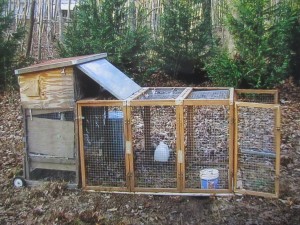
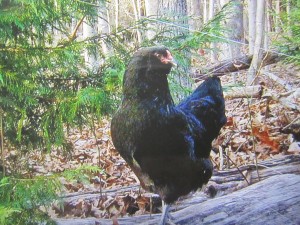
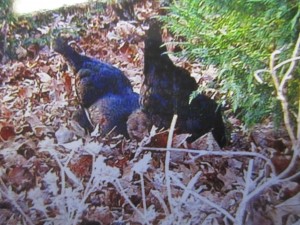
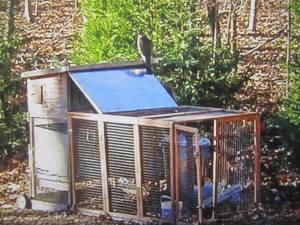

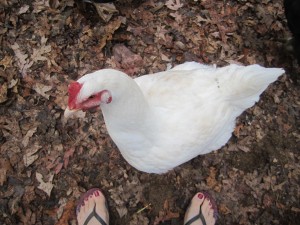
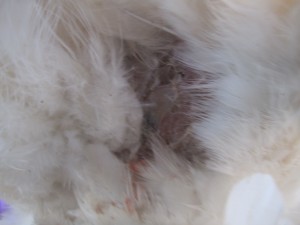
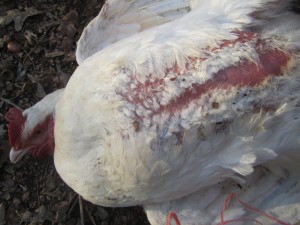
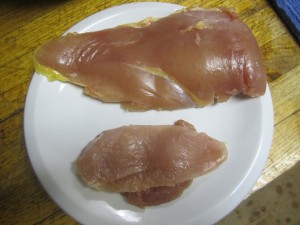
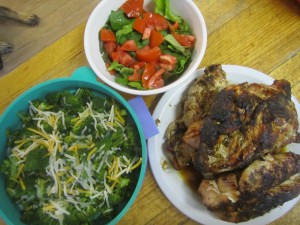



February 8th, 2013 @ 12:42 pm
You should try “Freedom Ranger” meat chickens. They a meat bird that was originated in France for the specific purpose of having a fast growing meat bird that isn’t as gross and slovenly as the Cornish cross. They come from a hatchery in PA. I grew 15 last year and loved them! I butchered them at 10 weeks old and they all were about 5 lbs. cleaned and gutted. They move around a lot more than the Cornish and will actually scratch and pick through a lot of dirt and pasture for food. They still need to be fed grain to get maximum meat and they don’t roost very much, but they are definitely less gross than the Cornish.
Good luck with your chickies!
February 8th, 2013 @ 2:15 pm
Another blog I follow did a side-by-side comparison of regular roosters vs. Cornish crosses like you did, but looked further. Some of the internal organs of the CCs were enlarged and looked diseased, and they thought the meat was tasteless with a nasty texture. They’ve sworn off Frankenchickens. Me, I enjoy hens for their eggs, personalities, and scrap clean-up. I wasn’t comfortable eating meat as a kid; I refuse to now.
Michelle at Boulderneigh
February 8th, 2013 @ 6:45 pm
Very interesting! I raised Cornish Rocks for the first time this past fall. They threw in a few layer breed cockarels, which I decided I would raise for meat, as well. Huge difference in the meat. The CRs had vastly more meat, and it was much tastier. The cockarels were skinny and not as tender/tasty.
I liked my CRs just fine. I raised them with my layer hens, and I found them to be funny and active.
And I had no trouble transporting them to be processed.
I only raised nine, so perhaps that helped. I’m planning on raising 50 this summer, 1/2 for me and 1/2 for a friend. I’m a little nervous.
February 9th, 2013 @ 2:25 am
Meating my meat is something I have been grappling with. I’m no vegetarian and currently am part of an organic chicken cooperative- for the eggs and the love of chickens. Members have been talking about “processing the birds” since the beginning and I just don’t think I can handle that- picture Silence of the Lambs with chickens. I always enjoy your writing even when I’m being alittle freaked out.
February 9th, 2013 @ 8:06 am
After raising Cornish crosses for two years in a pen, last summer we decided to free range them instead. Although I butchered them much earlier than you did, I found that they did better free ranging with the rest of my flock. And like you said their legs were stronger, they grew more feathers in their hearts and gizzards were in better condition when we butchered them at six weeks. The average dressed weight was four and three-quarter pounds. By free ranging them during the day and feeding them only at night when they were cooped, up they did excellent. Last year we also experimented with a new feed by Neutrina that was designed especially for meat birds. The cost is about a dollar more per bag and it was 10 pounds less, but they eat less of it than my regular feed, so it ended up being cheaper. And they were at my butcher weight two weeks earlier. And since it’s a feed that you can use right up till butcher it made it easier and the meat was just as flavorful if not more so, but with a lot less fat than previous years. So that’s how I plan on raising them again this year. I normally raise about 25 a year. I also age my meat in the refrigerator for three days prior to freezing. This allows for all stages of rigor mortis to complete and makes the meat a lot more tender.
February 9th, 2013 @ 9:09 am
We’ve always raised freedom rangers, but I know several people who like the taste and texture of Cornish crosses better. A friend of ours free ranges his Cornish cross, and he says they do very well, so long as they are not provided free-choice feed. They have to be motivated to move around. It takes longer for them to grow, but he says they have more flavor. We might try both this year.
February 9th, 2013 @ 9:13 am
By “takes longer to grow” I mean to compare the free ranging Cornish chickens to the totally grain fed ones. The Cornish crosses will grow faster than the freedom rangers.
February 9th, 2013 @ 12:35 pm
This whoe story grosses me out, buying would love for Grant to see chickens butchered. Ahh, childhood memories. Sign him up for being a poker….
February 10th, 2013 @ 6:27 am
We raised a batch of Cornish cross roosters, and they were disgusting! We did too many in too small of a space, being used to raising our regular chickens. We should have only had about half what we had. They ate and pooped and ate and pooped, etc. I swore I would never do them again—until we tasted them. They were delicious and tender and so much plumper than our extra roosters that we had eaten up to that point. We haven’t done anymore since then, but I’d be willing to take them on again, but probably only a dozen or so at a time.